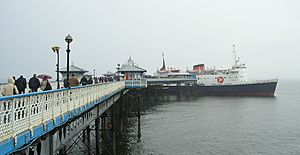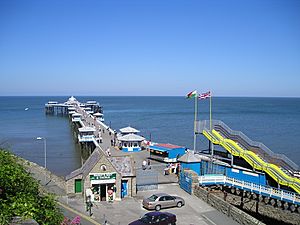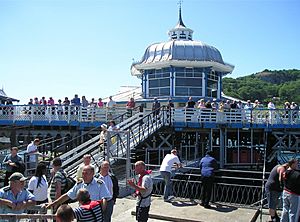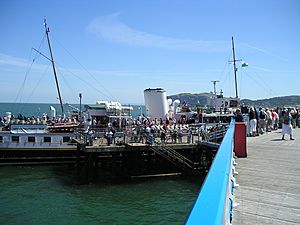Llandudno Pier facts for kids
Llandudno Pier is a very special pier in the seaside town of Llandudno, North Wales, United Kingdom. It's so important that it's a Grade II* listed building. This means it's a historic place that needs to be protected.
At 2,295 feet (700 m), this pier is the longest in all of Wales. It's also one of the longest in England and Wales! In 2005, people who love piers voted it "Pier of the Year."
At the very end of the pier, there's a special platform called a landing stage. This stage was rebuilt in 1969 and again in 2012. It's used by ships like the PS Waverley or the MV Balmoral for special trips. Sometimes, ships from the Isle of Man Steam Packet Company even use it for journeys to Douglas, Isle of Man.
Contents
Where is Llandudno Pier?
The pier is located on the coast of North Wales. It sits between the towns of Bangor and Colwyn Bay. What's cool about this pier is that it has two entrances! One entrance is on the main promenade, called North Parade. The other, older entrance is on Happy Valley Road. The famous Grand Hotel is right between these two entrances.
The Pier's History

The very first pier here was much shorter, only 242 feet (74 m) long. It was built on wooden poles and opened in 1858. Sadly, a huge storm in 1859, called the Royal Charter Storm, badly damaged this first pier. Even though it was fixed, it was too short. Only steamships could use it, and only when the tide was high.
The pier you see today was designed by clever engineers named Sir James William Brunlees and Alexander McKerrow. It was built by John Dixon. The pier officially opened to the public on August 1, 1877. Later, in 1884, the pier was made even longer towards the land. A new landing stage was added in 1891.
In 1969, the landing stage was completely rebuilt using strong concrete and steel. This made it possible for even bigger ships to use it. The wooden parts of the pier have been fixed up many times over the years. Today, the pier is owned by a company called Tir Prince Leisure Group.
The Pier Pavilion
For many years, people had to pay a small fee to walk onto the pier. This fee allowed them to enjoy music from a bandstand at the end of the pier. A small orchestra started playing there in 1877. A famous French musician, Jules Rivière, became the leader of the orchestra in 1887.
The orchestra's performances later moved to a special building called the Pier Pavilion. This large theatre was built next to the main pier entrance and opened in 1886. Rivière's Orchestra grew very big, becoming a full symphony orchestra! Sadly, the pavilion was destroyed by a fire in 1994 and was never rebuilt.
Awards and Recognition
- 2005 — National Piers Society — Pier of the Year
Images for kids





